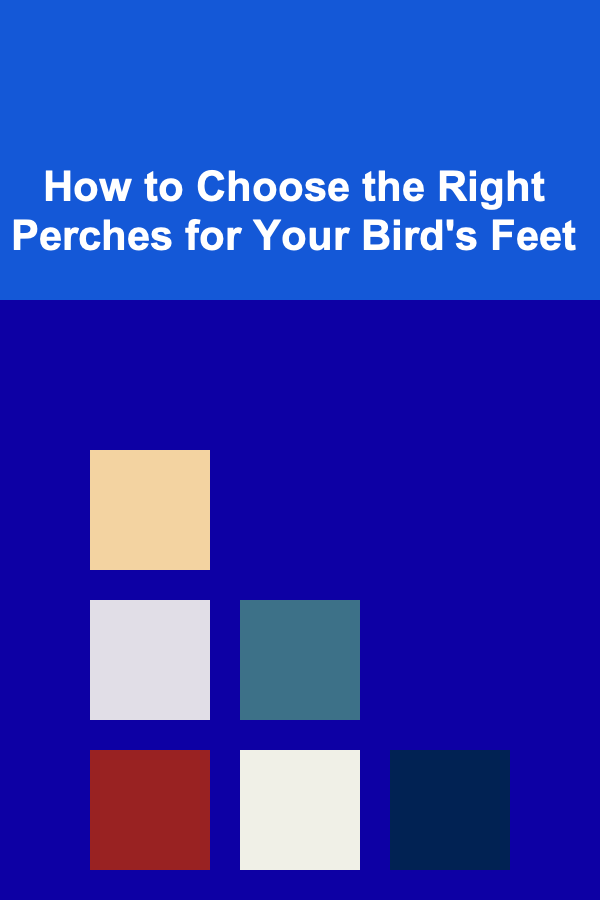
How to Choose the Right Perches for Your Bird's Feet
ebook include PDF & Audio bundle (Micro Guide)
$12.99$8.99
Limited Time Offer! Order within the next:

Choosing the right perches for your bird's feet is an essential yet often overlooked part of pet bird care. The wrong perch can lead to serious health problems, including foot deformities, pressure sores, and even behavioral issues. The correct perches provide not only a comfortable resting place but also promote foot health, encourage natural behaviors, and improve overall well-being. This article will explore the importance of choosing the right perches for your bird, the different types of perches available, and practical tips for creating a healthy and comfortable environment for your pet bird.
1. Understanding the Importance of Perches for Birds
Birds, like all animals, require a safe and comfortable space to rest. In the wild, birds spend much of their time perching on tree branches, which vary in size, texture, and shape. Perches provide birds with a place to sleep, eat, preen, and engage in other natural behaviors. For pet birds, it is just as important to recreate these natural conditions to ensure their health and happiness.
- Foot Health: Perches serve as one of the primary ways to maintain your bird's foot health. An improperly sized or shaped perch can cause a range of issues, from pressure sores to tendon problems.
- Mental and Physical Stimulation: Birds in the wild are constantly moving between branches of different textures, diameters, and lengths. This variety in perching promotes exercise and provides mental stimulation. The same principle applies to pet birds --- a variety of perches can keep your bird active and engaged.
- Natural Behaviors: Perches mimic the natural environment and give birds the chance to perform behaviors they would typically engage in, such as gripping, hopping, and moving between different surfaces. These activities keep your bird physically fit and psychologically stimulated.
2. Types of Perches and Their Benefits
There are several types of perches available for pet birds, each with different materials, shapes, and functions. Understanding the differences can help you choose the right options for your bird.
2.1 Wooden Perches
Wooden perches are the most natural choice for birds and are often favored for their versatility and comfort. Wood is soft enough for birds to grip easily, but sturdy enough to support them.
-
Benefits:
- Natural Feel: Wood closely mimics tree branches, providing a familiar and comfortable surface for birds to perch on.
- Variety in Diameter: Wood allows you to provide perches in various thicknesses, which is important for exercising your bird's feet.
- Chewing Opportunity: Many birds enjoy chewing on wooden perches, which can help keep their beaks trimmed and healthy.
-
Considerations:
- Choose untreated, bird-safe wood to avoid harmful chemicals that might be present in some commercially available wood.
- Popular choices include hardwoods like apple, willow, and manzanita.
2.2 Natural Branch Perches
These perches are made from actual tree branches, often harvested from safe, bird-friendly trees.
-
Benefits:
- Irregular Shapes: Natural branches come in different shapes and sizes, making them ideal for mimicking the natural environment. Birds can grip different sections of the branch, which offers foot exercise and variety.
- Slightly Softer: Natural branches often have a slightly softer texture, which can be gentle on a bird's feet while still providing a good grip.
-
Considerations:
- Sanitation: It's essential to ensure the branches are free of pesticides, chemicals, and parasites before using them in your bird's cage.
- Regular Replacement: Natural branches can wear down over time, and some species of wood might splinter or become too rough.
2.3 Concrete Perches
Concrete perches are often recommended for pet birds because they help maintain the proper foot condition by gently wearing down the nails and beak.
-
Benefits:
- Nail Trimming: Concrete helps keep your bird's nails at a healthy length, reducing the need for frequent nail trims.
- Variety of Sizes: Concrete perches come in various sizes and shapes, providing birds with more options for perching.
-
Considerations:
- Comfort: Concrete perches can be harsh on a bird's feet if they are too rough. Make sure to choose one with a smoother finish or cover it with a softer material, such as sandpaper or a cloth cover.
- Not for All Birds: While some birds love concrete perches, they may not be suitable for all species. Birds with sensitive feet or those not accustomed to concrete may find them uncomfortable.
2.4 Plastic and Acrylic Perches
Plastic and acrylic perches are lightweight, easy to clean, and come in a variety of colors and shapes. These perches can be fun, especially for decorative cages.
-
Benefits:
- Easy to Clean: Plastic and acrylic perches are non-porous, making them easy to wipe clean, which helps reduce the risk of bacterial build-up.
- Lightweight: These perches are usually lighter than wood or metal, making them a good choice for smaller birds or for those who prefer a minimalist design.
-
Considerations:
- Slippery Surface: Some birds may find plastic and acrylic perches slippery, especially if the surface is smooth. Choose a textured or roughened version to provide a secure grip.
- Durability: Plastic and acrylic perches may not be as durable as natural wood perches, especially for larger or more destructive birds.
2.5 Cuttlefish Bone Perches
Cuttlefish bone is a popular material used in bird perches, known for its ability to help keep birds' beaks and nails trimmed.
-
Benefits:
- Beak and Nail Care: Cuttlefish bone provides a gentle abrasion, helping birds maintain proper beak and nail length.
- Low Cost: Cuttlefish bone perches are often affordable and easy to find in pet stores.
-
Considerations:
- Fragility: Cuttlefish bone perches can be fragile and break easily, so they may not be suitable for larger or stronger birds.
- Brittleness: Some birds may attempt to chew on the cuttlefish bone, but it should not be consumed in large quantities, as it can be too abrasive.
3. Choosing the Right Size and Shape for Your Bird
The size and shape of perches are crucial in ensuring they are comfortable and healthy for your bird. A perch that is too small, too large, or too uniform in shape can lead to foot problems.
3.1 Diameter of the Perch
Birds need perches of different diameters to exercise their feet properly. A single, uniform-sized perch can lead to foot problems like arthritis or pressure sores. The perch should allow the bird to wrap its toes fully around the surface, gripping it securely.
- Small Birds: For smaller birds, such as budgies, finches, or canaries, choose perches that are ½ to 1 inch in diameter.
- Medium Birds: For medium-sized birds like cockatiels or lovebirds, perches should be 1 to 1.5 inches in diameter.
- Large Birds: Larger birds like parrots or macaws require perches with diameters of 1.5 inches or larger to accommodate their stronger feet.
3.2 Variety in Shape
Birds benefit from having perches of different shapes to encourage natural movements and foot exercise. Include perches that vary in both diameter and shape --- straight, curved, or spiral shapes --- to keep your bird engaged and active.
- Straight Perches: These are simple and common, but they should be supplemented with other types of perches for variety.
- Curved or Irregularly Shaped Perches: These perches encourage the bird to grip in different ways, which can improve foot health.
3.3 Multiple Perches at Different Heights
In a natural setting, birds don't just perch on one branch; they move between various spots at different heights. In the same way, your bird's cage should have multiple perches placed at different heights to encourage exercise and provide variety.
- Access to Food and Water: Place perches close to your bird's food and water dishes, but not directly on top of them, to maintain cleanliness.
- Space for Movement: Birds need room to fly or hop from perch to perch. Ensure that your cage is large enough to allow for free movement.
4. Maintaining Perches and Foot Health
Just as important as choosing the right perches is maintaining them. Clean perches regularly to prevent the buildup of waste, food, and bacteria, which could cause foot infections or diseases.
- Disinfect Perches: Use safe, bird-friendly disinfectants to clean perches and avoid using harsh chemicals that could harm your bird.
- Check for Wear and Tear: Over time, perches can wear down or develop sharp edges. Regularly inspect perches for damage or splinters and replace them when needed.
- Rotate Perches: To prevent overuse of a single perch, rotate the positions of perches or replace them with new types. This will ensure your bird gets the necessary foot exercise and mental stimulation.
5. Conclusion
Choosing the right perches for your bird's feet is a critical aspect of their overall health and well-being. A variety of perches in different materials, shapes, and sizes will provide your bird with the exercise, stimulation, and comfort they need to thrive. Whether you choose natural wood, concrete, plastic, or a combination of materials, remember that foot health should be a top priority. Regular maintenance, cleaning, and inspection of perches will help ensure your bird's feet stay healthy, preventing common foot problems and promoting an enriched and happy life for your feathered friend.
Reading More From Our Other Websites
- [Home Holiday Decoration 101] How to Decorate Your Home for the Holidays on a Budget
- [Home Family Activity 101] How to Plan a Family Art Show with Homemade Creations
- [Organization Tip 101] How to Arrange Equipment for a Safe Workout Environment
- [Home Space Saving 101] How to Select Small Patio Furniture That Makes Your Outdoor Space Feel Grand, Not Cramped
- [Home Pet Care 101] How to Choose the Best Pet Toys for Your Dog or Cat
- [Home Storage Solution 101] How to Create a Closet Organization System for Maximum Efficiency
- [Personal Care Tips 101] How to Make a Hair Mask at Home: A Comprehensive Guide
- [Home Cleaning 101] How to Clean Curtains: Keep Your Window Drapes Spotless
- [Rock Climbing Tip 101] Best Tips for Transitioning From Gym Climbing to Outdoor Crag Adventures
- [Rock Climbing Tip 101] Recovery Recipes: Post-Climb Meals to Repair Muscles and Replenish Energy

How to Leverage Party Planning Companies for Innovative Ideas
Read More
How to Make Your Christmas Tree Stand Out with Unique Decorations
Read More
How to Market Your Small Goods Store and Attract Customers: An Actionable Guide
Read More
Turning Deep Learning Projects into Long-Term Passive Income
Read More
How to Sketch Everyday Objects: Foundational Practice
Read More
Family Harmony Through Feng Shui: Strengthening Bonds
Read MoreOther Products

How to Leverage Party Planning Companies for Innovative Ideas
Read More
How to Make Your Christmas Tree Stand Out with Unique Decorations
Read More
How to Market Your Small Goods Store and Attract Customers: An Actionable Guide
Read More
Turning Deep Learning Projects into Long-Term Passive Income
Read More
How to Sketch Everyday Objects: Foundational Practice
Read More